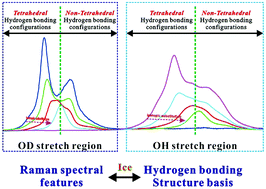Interpreting the Raman OH/OD stretch band of ice from isotopic substitution and phase transition effects
Abstract
Understanding the OD/OH stretch band (ODSB/OHSB) features for the Raman spectra of ice remains a challenge. This study measures the ODSB/OHSB for isotopically substituted D2O/H2O (with volume ratio VD2O/VH2O of 1/0, 4/1, 1/1, 1/4 and 0/1) ice Ih, and compares them with those for liquid water and ices in various phases. The data show that istopic substitution (IS) narrows the ODSB/OHSB of ice from both the low-frequency and the high-frequency side to the middle of the OD/OH stretch regions, but in contrast, IS enhances the high-frequency part of the ODSB/OHSB for liquid water. The ODSB/OHSB features of ice and their dependences on IS and phase transition can be understood basically from the concept that ice has diverse HB configurations that depend on the ice lattice form and the proton (dis)order and essentially determine the intermolecular vibrational couplings in ice. Combined with a Gaussian fitting analysis, more details for the HB configurations in ice are revealed: tetrahedral HB profiles, which are responsible for the main peak, are dominant and non-tetrahedral ones, which bring about the high-frequency shoulders, are also important. On IS, the proportion of tetrahedral HB profiles sees a dramatic decrease.



 Please wait while we load your content...
Please wait while we load your content...